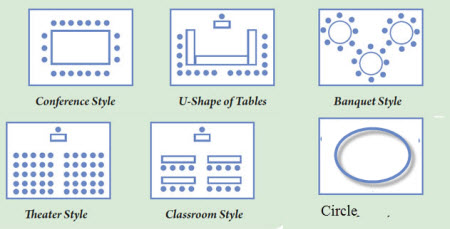
Yesterday, I spent a day facilitating leadership workshops for arts leaders attending the Art House Convergence Conference near Park City, Utah. on personal and organizational resilience based on the ideas in my new book, The Happy Healthy Nonprofit.
As a long-time trainer, professor, and teacher, I feel strongly that interactive learning activities – going beyond the death by Powerpoint Lecture – is the key to retention and application for participants. Your room set up can support your instructional activities that engage participants or get in the way.
I’ve spent a lot of time trying to understand how the feng shui of a classroom impacts learning. Circles without tables, just chairs helps promote group discussion. Having a large enough space so people can move around and self-organize into small groups also promotes learning. Classroom style with desks puts a barrier between the students and the instruction, especially when people are using laptops or tablets to take notes. If you are trying to do an interactive lecture, it stops group interaction. That’s why I always enjoy teaching in flexible classroom spaces.
However, I don’t always have that opportunity because many times nonprofit workshops are hosted at conferences at hotels. I’ve learned over the years to be very explicit about the room set, providing written descriptions, diagrams, and having a pre-workshop conversation about it. Despite this due diligence, sometimes you show up early to discover the room set up is not what you asked for. What to do?
I had designed the leadership workshop on resilience to include a lot of solo and peer reflection time and small group work and some small amounts of presentation and context to do the exercises. You can build your resilience by listening to a lecture! I had requested 6 person rounds because part of the exercises included some fun brainstorming processes and exercises. When I entered the room, the layout was a traditional theatre style, with chair oriented towards the screen.
When it came time for the small group work, I had participants count off and then asked for a table leader for each station. Then asked participants to move their chairs to the appropriate station. I involved in what I call “room hacking,” (when you have to rearrange furniture in a training room to accommodate a more interactive style of delivery). I also had them move them chairs back at the end.
This accomplished a few things: I didn’t have to trash my plans and revert to a traditional lecture. I made it participatory so participants helped move the furniture. It also provided a nice transition between sections, giving people a little brain break to digest the information.
Have you ever had to do a room hack? What was your experience?

Leave a Reply